Discovering That Glazing Is Amazing - action research PG Cert
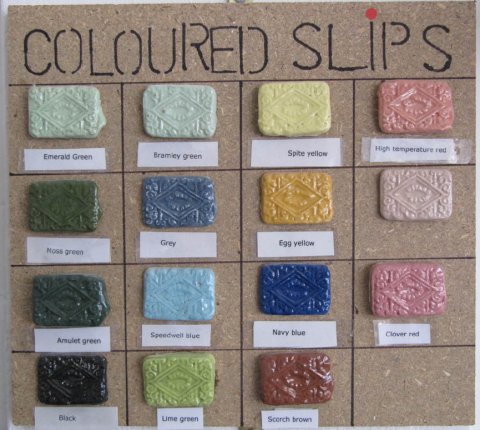

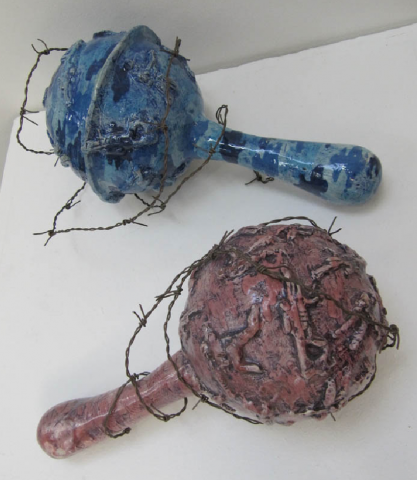
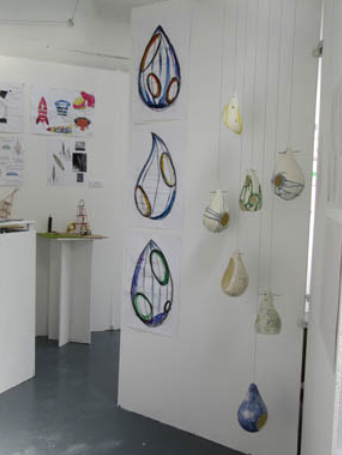




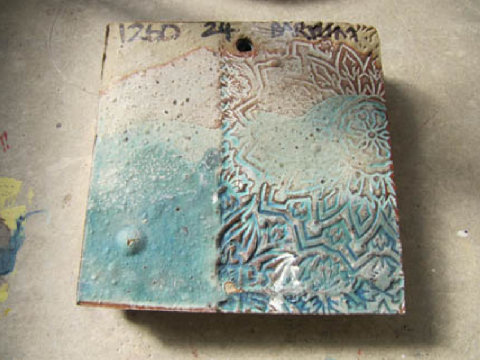
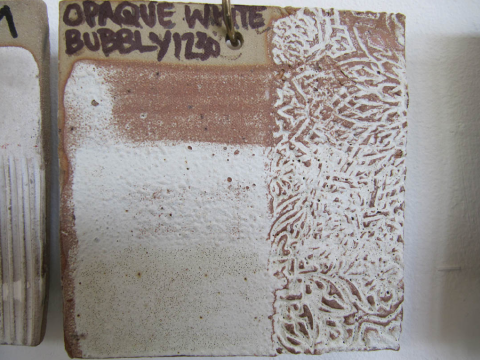


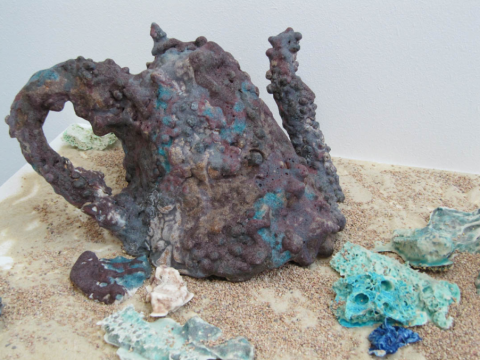
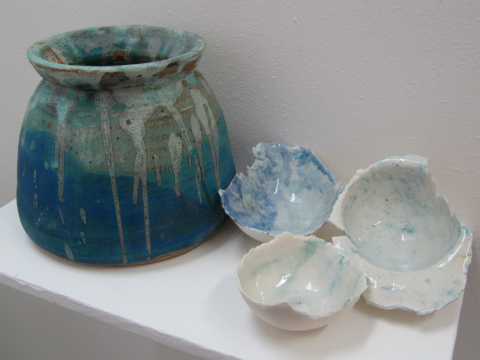

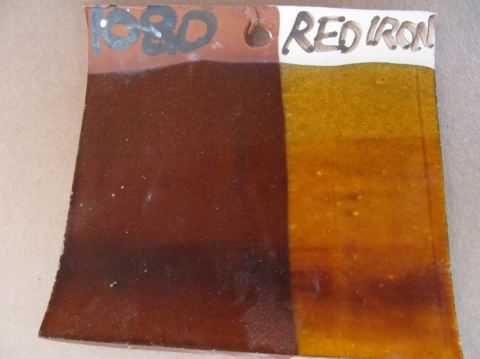
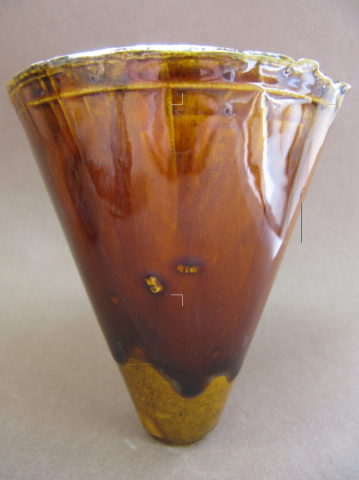

PG Cert Learning and Teaching 2010
Manda Helal, Ceramic & General Technician
WCA Foundation - Manda's blog - http://pandaji.wordpress.com/
Discovering That Glazing Is Amazing
Introduction
Glazing is amazing, but the process can be time-consuming and hard to grasp for the beginner. I wanted to make it easier and faster for students to discover the potential decorative intricacies of glazes, and to help them have a sense of satisfaction with their finished work.
This action research arose from the following:
- The nature of the three-day taught week and increased demand for autodidactic style learning has given me empathy with the students, for the part time structure that the Foundation course has become.
- The comments of a student in Foundation at Wimbledon who told me that at one of the BA courses she had applied to, the first term was spent doing only tests and experiments. She felt that this must be a good practice as she thought it would help her better understand the very complex nature of the ceramic process and glaze decoration. The student was wondering why we didn't do more of this at Foundation.
- To prevent wasted resources and the usual accumulation of unglazed work from the taster sessions in the first term referred to in my profile for unit 1.
- My own difficulty with understanding the glaze tiles resource when I first arrived at Wimbledon, and the way I was taught-melting raw ingredients and then trying to figure out why a glaze worked in a particular way, which is analogous to learning how to bake a cake by cooking all the ingredients separately.
The action research question I came up with is as follows:
"If I encourage the use of tests and experiments, will this enhance the learning experience of my students, and if so, how?"
I made a presentation to my tutor group about my action research idea. I received positive feedback from my peers. In response to the question: "How clearly has the author stated the focus and scope of the project?" one of my colleagues said: "it was specific to lack of tutor contact hours and students' comments about lack of formal teaching." When asked about the significant impact on the students' behaviour, the same colleague said it would "mean that they would take more responsibility for their own learning."
I would have preferred the intervention to happen in the first term taster sessions, or right at the start of the second term when the students would be starting their main area subject, not in the final term, when the pressures of deadlines were increased.
After analysing the results, I concluded that encouraging tests did help enhance student learning, and during feedback discussions, it had the unintended outcome of also encouraging peer learning. The amount of unglazed work left over at the end of this year was minimal compared to previous years. My understanding of the action research results has boosted my own self-esteem. I have publicised my work on a personal blog (Helal,M. & Helal,D 2010).
Intervention
- To help understand how the thickness of a glaze alters its appearance, I provided a template, (see Appendix 1) and a workshop discussion about how to read the glaze test tiles.
- To encourage testing, I provided tiles of various clay types ready for glaze testing and I made laminated guidance notes on glazing (see Appendix 2). I notified students of kiln firing schedules in advance by putting a chart of scheduled firings on the kiln room door.
- I informed the student group and staff about the innovations and explained that I was doing this as part of my own studies.
After the workshop discussion about glaze tests and the information one can gain when one knows how to read them, the students gave feedback that I then acted on. As a result, I felt that the emphasis of the research project changed. Not only were the students doing glaze tests, they were also helping each other with these and other ceramic techniques.
The peer learning part of the project occurred for the same reasons as the glaze testing. During a group discussion on glaze test results, I suggested the chart of techniques under which people could sign up if they felt they were confident enough to be able to answer questions or show someone how to do a particular thing. For example, make a mould or perform a glaze test (see Appendix 3).
Evaluating the project, I used recordings of discussions, a short questionnaire, and my personal observations and reflections. By inviting discussions of glaze test results with the student peer group, (see Appendix 4) I hoped to show:
- An increased understanding of the way the thickness of application can totally change the appearance of the same glaze;
- Realisation of the decorative potential and further testing of glazes; and
- The possibility of students' standardised tests becoming part of the glaze tile resource.
As part of my approach towards all resources, and because it is useful to perform tests on work with a vertical aspect to see the movement of glaze ("drips"), I encouraged the use of unglazed pieces left behind by previous students. I observed that those students who had experienced transformative learning during the course used vocabulary and language akin to an expert in the field. The questions being asked by students were indicative of an understanding of the glazing process compared to previous comments, which revealed total confusion about this process. The ability to understand this difference is a "threshold concept" in ceramics. Understanding the difference makes the learner realise the complexities and opens up the subject for further exploration (Meyer and Land 2006:3).
By encouraging the sharing of their test results with the group and generating discussions in an informal way, many students were able to increase their confidence and knowledge of glaze techniques, learn from each other, and feel comfortable asking questions or making suggestions.
Background
I am the Ceramic and General Technician at Wimbledon College of Art, on the Foundation Diploma in Art and Design course. I am solely responsible for the ceramic studio, and my general responsibilities are shared across all subject areas with the technical team. I have been working two days a week since 2006. I am concerned about cuts in education throughout the country. Ceramics courses are closing down across the UK. Over the last 10-15 years, three ceramic degrees in England have closed. Since the article about ceramic course closures, four more ceramic degrees courses in London Camberwell, Chelsea and Harrow and Glasgow, have closed (Ceramic course closures 2008,2009).
I am equally concerned that students at Foundation level have two days a week of self study, which provides the study environment, but does not actually offer any teaching. I have empathy for the students' "will" to learn that Barnett (2007) relates. It certainly takes all the "will of being a student" under these circumstances. I hoped by encouraging tests, to help students take responsibility for their own learning.
This past year at Wimbledon there has been a cut in ceramic tutor hours from two days a week in 2008-2009 to one day a week in 2009-2010. My working hours have actually increased, as I am doing an extra day as a general technician while my colleague is on sabbatical. This has meant an increase in the number of kiln firings per week, and more contact time with both students and colleagues. Although I work in the general workshop on my extra day, it is physically opposite the ceramics studio, so if a ceramic student needs my help they can access me easily.
Because the study day for the PG Cert course is on a Friday, I have changed my working day to Thursday for the duration of the course. This has given me a whole new perspective, because the majority of students attend on Thursdays, whereas on Fridays attendance is not very high because of the concept of self-study, and because some students work to support themselves.
My main concern, (apart from helping students realise their creative potential), was that more than the usual two students would choose ceramics as a final subject area at Foundation and at degree level. The time required to produce a finished piece of ceramic work is longer than the two-week taster project length, so students have often moved to their next subject taster and do not complete the glazing of their work. As student 4 pointed out: "by the time we think about glazes it's too late."
I wanted to help students to start thinking about the final finish and glaze before "it's too late." In order to complete their work, they have to find time out from their next project to return to the ceramic studio and do the glazing. This is too difficult for most students, hence the accumulation of unglazed work at the end of the first term.
The anticipation of the final appearance of the glaze on a piece of work in Grayson Perry's view, is " always a disappointment" (Perry, G. 2010). Occasionally, the kiln does something unexpected and "gifts" a glaze result that one could not have imagined even after years of tests. I have referred to these as "kiln gifts" in my previous profiles. Grayson Perry concludes: "It is only when other people admire the work that one feels better about it" (Perry. G. 2010).
All the students at Foundation are encouraged to use a wide variety of materials and techniques, which form a part of their self- and summative assessment (Appendix 5). I agree with Grayson Perry when he says "creativity is in the process" (Perry. G. 2010).
Glazes are just part of the decorative potential of ceramics. I made charts of simpler-to-use colours that look much the same before the kiln firing as after.
(See Plate 1 Charts of stain and slips)
They are similar in behaviour to using watercolour paint, and therefore more likely to be used by students who are less prepared to take risks, or who want a particular outcome and who may not make, experiment, or understand how to use glazes. The tutor Annie Turner usually demonstrates decorative techniques using these colours during the first term taster sessions.
(See Plate 2 Examples of final works by students using slips and stains)
I had considerable difficulty learning about glazes and glazing. It has always been a challenge. Providing learning resources such as standardised examples of glazed tiles makes this process easier for the students to learn about the application of glazes, to realise the glazing possibilities, and for myself to teach.
The glaze tile resource at Foundation was disorganised when I started my job at Wimbledon four years ago. The tiles were not labelled and they were haphazardly arranged, rendering them dysfunctional as a learning resource. On my arrival, I was encouraged by the tutor to familiarise myself with the glazes. I remember feeling overwhelmed by the prospect, so I agree with the student who responded: "it's quite daunting" when I asked if the standardised test tiles were inspiring during a group discussion.
The more practice one acquires at glazing, the better at it one becomes. It is productive to break the process down into small chunks of information that can be easily understood. The glazes are handmade in the studio from raw materials that resemble varying shades of white powders. They have to be accurately weighed and sieved. By spending time on the glaze process, students can begin to discover the infinite decorative possibilities outlined in my presentation of my Action Research Proposal (1001 cups, 2010).
LITERATURE REVIEW
Action research is a method of "enquiry into the self by the self." (McNiff, J. 2002).
Jean McNiff, (2002) states, "A useful way to think about action research is that it is a strategy to help you live in a way that you feel is a good way. It helps you live out the things you believe in, and it enables you to give good reasons every step of the way."
The method is to identify an aspect you want to investigate, plan an intervention, try out the plan, evaluate the results, reflect on them, and then identify the next step from the questions or problems generated by the last cycle. This is a life-learning process.
The creative process and learning through mistakes
The phenomenon of the motivational forces that appear to spur artists to engage in artistic production have been noted and described in various ways. Lee Emery collates these descriptions in his article Believing in Artistic Making and Thinking (Emery, L. 1989). Piaget (1952) referred to "disequilibrium as providing a force for thinking," while G.M. Mead (1934) referred to "impulse as a disturbance of equilibrium." Ross (1978) described it as "The antagonistic principle" and stated: "The creative individual enters into a contest which involves some pain." Ross also wrote about the artist as seeking to resolve "some felt disturbance" Ross (1978). Ross perceived the artistic process as involving risk and difficulty. Earlier, Dewey described it as a form of enquiry, beginning with a "felt difficulty" Dewey (1910, p. 72). Dewey also stated: "The artist has his problems and thinks as he works."
Langer (1959) contended that when the artist works in empathy with the artistic process, the "very fibres of the body are affected." Grayson Perry has a motto above his studio door that reads: "creativity is mistakes" and in his opinion, it is "the thing that is so difficult to deal with" (Perry. G. 2010). In my opinion, creativity means allowing for mistakes to be of use. This was beautifully illustrated by student 3's final showpiece made of paper porcelain and lining a rusty exhaust pipe that was cut in half.
(See Plate 3 Student 3 Final Piece photo)
The work was built absolutely straight and I propped all but two places, where, during the firing, it slumped outwards. One place exactly matched a rusted part. For the other, we had to bend the pipe in order for it to fit snugly. The student was disappointed with the piece because she expected it to be straight. However I thought the piece had wabi sabi and was a "kiln gift." The student's acceptance of the "mistakes" was the hardest part for her to deal with. To ensure her piece would stay straight, it could be propped all the way along. Conversely, to make one which slumps in exactly the right places would now be possible because of the learning gained from this experience. My own learning also increased because of this "mistake."
In response to my Action Research Questionnaire, students made their own observations on learning through mistakes:
"Being able to try and experiment something out for myself really helped me to learn by trial and error."
And:
"I found it extremely useful. It was nice to be able to learn from my own mistakes and get some really interesting results."
These observations support Danvers' (2003) conclusion of the importance of learning through failure.
Peer Learning
I was interested to find out if I could encourage peer learning by providing a list that people sign when they are confident that they can teach someone else a particular technique. Boud (2004) noted that reciprocal peer learning can help a student develop a transferable skill of peer collaboration that will extend into their lifelong learning and professional development. I agree with this statement. We do not live in isolation we are all increasingly more connected. Collaboration and the ability to share and help another person in their endeavours is a useful life skill.
Feedback
"If students discuss feedback on their assignments, in class, they are more likely to think about it and take it seriously" (Rust et al, 2003). The Foundation programme includes a group project in order to facilitate Rust's statement.
In relation to collaborative and shared learning, I initially agreed with the statement "Sharing tacit knowledge requires interaction and informal learning processes such as storytelling, conversation, coaching and apprenticeship" (Wenger et al. 2002) until I realised that the model was co-opted by companies such as Procter and Gamble the makers of disposable nappies. I now agree with Grayson Perry when he concludes that "creativity needs to be reassessed, creativity drives the capitalist monster that is killing the planet and creativity has overstepped the mark and we need to contain it" (Perry. G. 2010).
Transformative Experience
I wanted to see if I could enhance students' understanding of threshold concepts of ceramics. "A threshold concept can be considered as akin to a portal, opening up a new and previously inaccessible way of thinking about something. It represents a transformed way of understanding, or interpreting, or viewing something without which the learner cannot progress" (Meyer and Land 2006:3).
Understanding one of these ideas is, according to Erik Meyer and Ray Land, (the principal researchers in the field), "like opening a door," revealing other aspects of the subject that hitherto have been hidden, and showing how they fit into place. They call these ideas "threshold concepts." "If you can identify the threshold concepts in your discipline, and if you can find better ways to teach them, and to assess whether students have really got them or not, your students will get much further" (Atherton, J. 2010). Therefore to be able to experiment for oneself and fully appreciate the outcome is a transforming experience.
When looking at a non-standard test tile (see plate 4), one cannot judge the original thickness, so one has to experience doing it for oneself to learn the correct consistency for a particular glaze. I agree with the following seven principles of good practice in undergraduate education as mentioned by Chickering & Gamson (1987).
Good practice:
1. Encourages contact between students and faculty;
2. Develops reciprocity and cooperation among students;
3. Encourages active learning;
4. Gives prompt feedback;
5. Emphasizes time on task;
6. Communicates high expectations;
7. Respects diverse talents and ways of learning.
I have consistently tried to adhere to these principles. The occurrence of all seven aspects can be recognised in the experimentation and performing of glaze tests.
METHOD
I had intended that the results of my action research would be in the form of recorded discussions with participating students so that qualitative data could be gathered and I could use their quotes as evidence. However, due to malfunctioning recording equipment, I had to transcribe what I could remember from the discussions (see Appendix 4).
I designed a twelve-question yes or no profile questionnaire and included one open question which was "please write about whether you found doing glaze tests and experiments helpful (or not), and if so, why?" (Appendix 6)
I have kept a reflective journal and visual diary of all the student ceramic projects and photographs of student tests and final pieces. For the action research I wanted to make it easier and less time-consuming for the students' decisions about glazing, and I wanted to know if students performing their own glaze tests in a standardised way would enhance their learning.
I made and hung some standardised glaze test tiles on the wall, so that they were highly visible.
(See Plate 5 Standard test tiles)
I then made a laminated template of the information on the test tile (see Appendix 1) and asked the students to do their tests in the same standardised way. I explained how these would be useful to future students. I gave individuals and small groups demonstrations of this standard glaze test. This included how to weigh and mix the glaze recipe and keep meticulous records of their own glaze recipes and tile labelling.
Occasionally, even after years of experience, if one is not familiar with a certain glaze one can still apply glaze too thickly or thinly. The application of glaze can be done in various ways, which include dipping, pouring, painting, and spraying. In my experience, this type of tacit knowledge is best conveyed individually or in small groups of 3-5 students. It allows time for students to ask questions and clarify their thinking.
Student 6 said:
"I prefer not to use glaze tests because it is time consuming." I agree that the process can take time, but hopefully the rewards are worth it. If a glaze has not been used for a while, it may become thicker in the container as a result of evaporation or even become solid. Knowing how to mix glaze to the correct thickness before applying can affect the final look of a piece. Learning to judge the correct thickness (tacit knowledge) can only be acquired through the experience of mixing and applying glazes.
I encouraged tests by making blank ready-to-glaze tiles. Students were offered these for their own standardised glaze tests. I also made a laminated "how to glaze" guide (Appendix 2). I put several copies in the glaze cupboard so that students (in my absence) could access the steps for mixing and testing the thickness of a glaze before applying it to a piece of work or test tile. I encouraged students to use them, even if they thought they could remember the instructions.
If blank tiles were not available, I made it clear that certain pieces left by previous students could be used for testing by keeping these on a clearly labelled shelf. Student 5 used one of these as his test piece because it was made from the same type of clay that he was using in his final work.
(See plate 6 Student 5 test piece)
When test results came out of the kiln, I spoke about the results with the student(s) concerned and any other interested students. This prompt feedback helps students realise the information gained from doing the tests and often promotes a decision about how to glaze work or further testing, if there is time.
For the recordings I used an ancient cassette recorder that had worked when I had tested it, but did not record a group discussion in a noisy studio. Worse still, I had not realised that it was malfunctioning and rerecorded a second discussion, which did not record. On the third attempt to record a group discussion using a computer, the original group who had more experience were not available.
The recorded discussion (Appendix 4) took place with a group of students who had not done any test tiles, but nevertheless through discussion produced another small change, in that I put up a skill-sharing chart (Appendix 3) to help students locate another student with the requisite skills if the tutor or myself were not available.
I also encouraged the students I felt were competent at a particular technique-but who had not signed the chart-to sign up. I often asked one student to explain something to another student and I followed up with the people involved to ensure they were comfortable with their roles.
During the discussions I responded to student feedback about the accessibility of the recipe book and labelled the test tiles with the recipe book page number. I intend to arrange the tiles in the boxes in numerical order so that they clearly correspond to the page in the recipe book. The tiles are only an indication of the visual appearance of the glaze after firing. The effect can change for many reasons, for example, if applied by someone else in a different manner, or placed higher or lower during the kiln firing. The benefit of testing a glaze for oneself is to ensure it will work in the intended way.
RESULTS & DISCUSSION
The student sample group of 10 although small, produced encouraging results.
The students' responses to the Action Research Questionnaire can be seen in the appendix. (Appendix 7)
The results indicated that 4 out of 10 had done ceramics prior to the Foundation course. That 8 of the 10 students chose ceramics, as their subject of choice is a fourfold increase from the previous two years. This was one of my goals in my introductory profile. I concluded that working on Thursdays instead of Fridays has contributed to the increase in uptake of ceramics as a subject.
Six students were continuing onto ceramics BA courses. This is a threefold increase from the previous two years. I regard this as a positive outcome, particularly as many craft-based and ceramic courses, are closing.
All 10 students learnt how to read a glaze test and performed their own glaze test tile during the Foundation course. Seven weighed and mixed raw materials to make glaze. In one student's words: "doing my own glazes was a wonderful way of learning about glazes."
Student 1
"Learning about how to make glazes from scratch I found very important and a huge section of learning about ceramics in general. I found the tiles available with glazes on them excellent for understanding layers, recipes, and colours achieved. I found wall charts with simple directions helpful to remind me how a sequence of steps is carried out."
These comments confirm that some students found it helpful to have information at hand in the form of charts and how-to-guides.
Student 7
(See Plate 7 Student 7 test pieces and final piece)
"Really helpful because I was able to understand how the recipes and chemicals worked and reacted together. And I learnt how a glaze can change dramatically from gram to gram of oxides for example. I made a glaze from scratch but added four different ingredients to each recipe and got four very interesting glazes on test tiles. Had I not been able to test them first I could have ended up with a final project with colours and glazes I didn't like."
The information gained by this student, through her tests, and through feedback and discussion, helped to achieve her intended outcome and to meet a deadline, as indicated by her final piece.
Student 4
(see Plate 8 Student 4 test pieces and final piece)
Although reluctant to do her own tests, Student 4 mentioned that "Normally I rely on the already glaze tests which are kept in the studio. I find they are useful enough for my studies." This comment indicates the usefulness of having the glaze tiles as a learning resource. She continues, "I have done a few tests myself in the past and they have had interesting outcomes, but to me there isn't any difference than the ones I have done and ones which already have been done. But I guess they are tests I can keep and record and I get to understand the thickness of it."
These comments indicate agreement with the action research objective of enhancing learning through performing glaze tests and experiments. One of the unintended outcomes of the research was the interaction between students discussing their glaze test results with each other. 8 out of 10 students said they had discussed their result with fellow students and all 10 said they had shared their thoughts about another student's work.
In response to the questions about peer-learning, all 10 students said that they found the chart for skill sharing really helpful and 9 said they had learnt a technique from their peers. Half the sample had taught a fellow student a technique. This was a positive result despite a small sample.
All students agreed that had they known beforehand that they were expected to show someone else a technique, they would have "learnt it better." This illustrates the pedagogic principle as Phil Race (2006) infers, how we can "help students learn more effectively, efficiently and enjoyably. Helping them make sense of what they learn and consolidating what they have learned by helping others learn."
During the discussions with students about their test results, the two- way feedback helped me take the next intervention, that of the peer- learning/skill-sharing chart.
Peer learning and discussions about one's work enhances the learning experience as the majority of students indicated.
My own learning
Glaze tests are a great way to promote feedback and discussion. After reading Bryan and Clegg (2006) I understand that assessment is also feedback, and so my previous understanding that I had nothing to do with student assessment has now changed. I understand that I constantly give feedback. Discussions about finished work are formative, as I am not required to do summative assessments in my role as technician. My understanding of formative feedback as a fast and helpful way of enhancing student learning has certainly helped me feel more useful and productive.
Formalising reflections using a reflective diary has given me a way of knowing that I am heading in the right direction professionally. I can continue to do action research projects and help my own and the students' progress. As a result, I feel more confident about my teaching abilities and feel that my colleagues can now take me more seriously. My teaching practice has always been my main occupation rather than my practice as a ceramic artist. Now I feel that I can take myself more seriously as both a ceramic and academic practitioner.
When I first arrived at Wimbledon I organised the existing glaze test tiles into boxes containing tiles fired to the same temperature. I noticed that students were reluctant to look through these boxes to find a glaze colour or effect that they wanted to use. During the short course English Design and Make 2010, one student was drawn to the student 7 test tiles that I had hung together on the wall.
(See plate 7 Student 7 test tiles)
The student said, "I want my mask to look as though it is crying. This glaze looks as though it's crying." After reflecting about this, it confirmed my thoughts that using student standardised test tiles has added to the resource and helped enhance the learning of the subsequent group of students.
Improving the way I display the tiles has demonstrated the importance of immediate visual appearance in helping students' decision-making.
By organising various samples into boxes classified in a more general way to allow for non-standard examples, I hope to encourage exploration of the resources and the cross-curricular use of clay.
CONCLUSION
The results so far have been encouraging, and have led to the following conclusions:
At my annual appraisal, it was agreed that working on Thursdays instead of Fridays has meant more contact with both colleagues and students, and it has had a beneficial effect. I have also had more contact with non-ceramic students and thus increased the cross-curricular use of clay. As a result, next year I will continue to work on a Thursday. This is a direct unintended outcome of attending the PG Cert course. The change of schedule may encourage more students to choose ceramics as a main subject or use clay in their projects.
In my reflective journal I describe a critical incident, during which I asked a foreign student to explain to someone else how he had achieved a particular glaze effect. After explaining, using the template and test tile, the student felt a sense of achievement that he expressed by giving me a high five. The student knew the person had understood because he commented that he had learnt the English word for "drip". The student also mentioned "I have never done any ceramics before".
(See plate 9 foreign student first glazed work using test tile)
I believe that my actions are student-focused and encourage a "deep approach" to their studies. Prosser and Trigwell (1999) showed that there is "some evidence that teachers who take a student approached focus to teaching and learning will encourage students towards a deep approach to study." Performing the glaze tests helped the students take responsibility for their own learning. I felt that the Action Research experience helped me enormously with understanding why my teaching methods are working and which aspects need improvement.
If I could plan the glaze test demonstration for the fortnightly taster sessions in the first term as part of the induction into the studio, it would hasten the understanding of the glaze possibilities and encourage students to make use of the existing glaze tests and experiments. It might also prevent unglazed work from accumulating at the end of the taster projects. The next batch of sample tiles will demonstrate the application of two different glazes, (double dipping), so that the students can continue to contribute to the glaze test tile resource. As my results show, any additions to the resource help students discover that glazing is amazing.
Bibliography
1001 cups (2010)
http://pandaji.wordpress.com/2010/08/10/action-research-project-1001-cups
Atherton, J. S. (2010), Doceo; Introduction to Threshold Concepts [On-line] UK: Available: http://www.doceo.co.uk/tools/threshold.htm
(Accessed July 21st 2010)
Barnett, R. (2007), A will to learn: Being a student in an age of uncertainty. Maidenhead: Open University Press and SRHE.
Bryan, C. and Clegg, K., (2006), Innovative Assessment in Higher Education Eds. Abingdon: Routledge.
Ceramic course closures (2008, 2009)
http://ceramicreview.blogspot.com/2008/12/save-harrow-ceramics.html
(Accessed July 16th 2010)
http://www.craftscouncil.org.uk/about-us/press-room/view/2009/briefing-notes-number-one
(Accessed July 14th 2010)
Chickering A. W. & Gamson Z. F. (1987), Seven principles for good practice in undergraduate education. American Association of Higher Education Bulletin, pp. 3-7. Full article at:http://honolulu.hawaii.edu/intranet/committees/FacDevCom/guidebk/teachtip/7princip.htm
(Accessed July 19th 2010)
Danvers, J. (2003),Towards a Radical Pedagogy: Provisional Notes on Learning and Teaching in Art and Design. JADE 22.1 ©NSEAD
Dewey, J. (1910) How We Think. Boston: D.C. Heath, p.72
Emery, L . (1989) Believing in Artistic Making and Thinking. Studies in Art Education. Vol. 30, No. 4 (Summer, 1989), National Art Education Association, pp. 237-248.
Friere, P. (1994) Pedagogy of Hope, Reliving Pedagogy of the Oppressed
London, New York: Continuum.
Helal,M. & Helal, D. (2010), Personal Blog about Action Research available from
Kolb, D. A. (1984), Experiential Learning: experience as the source of learning and development. New Jersey: Prentice-Hall.
Langer, S. (1976), Feeling and Form. London: Routledge and Kegan Paul.
McNiff, J. (2002), Action Research Booklet available from http://www.jeanmcniff.com/ar-booklet.asp
(accessed July 19th 2010)
Mead, G.H. (1934), Mind, Self and Society. Chicago: University of Chicago Press.
Meyer, J. and R. Land (2003) Threshold Concepts and Troublesome Knowledge: Linkages to Ways of Thinking and Practising within the Disciplines. Edinburgh; Enhancing Teaching-Learning Environments in Undergraduate Courses Project, Occasional Paper 4 [on-line, UK] available http://www.tla.ed.ac.uk/etl/docs/ETLreport4.pdf
(Accessed July 21st 2010)
Perry, G. (2010), Grayson Perry on Creativity and Imagination (Radio 4, 6th July 2010)
Piaget, J. (1952), The Origins of Intelligence in Children. New York: International Universities Press.
Prosser, M. and K. Trigwell. (1999), Understanding Teaching and Learning. The Experience in Higher Education, Buckingham:The Society for Research into Higher Education and Open University Press.
Race, Phil. (2005), Making Learning Happen Chapter 2, and The Lecturer's Toolkit (2006) Chapter 1.
Ross, M. (1978), The Creative Arts. London: Heinemann.
Rust, C., M. Price, & B. O'Donovan, (2003), Improving Students' Learning by Developing their Understanding of Assessment Criteria and Processes Assessment & Evaluation in Higher Education, 28,2, pp. 147-164.
Wenger et al. (2002), Cultivating Communities of Practice, . Cambridge, Mass: Harvard Business School Press, p. 9.
APPENDIX
Index of Appendix
1. Test tile template
2.How to glaze instruction sheet
3. Skills Sharing chart
4. Cd recording of glaze test discussion with students
5. Student Self assessment form
6. Action Research questionnaire
7. Action Research Questionnaire All 10 Responses
APPENDIX 1. TEST TILE TEMPLATE CLICK HERE FOR IMAGE
APPENDIX 2. HOW TO GLAZE A PIECE OF FIRED CERAMIC
BEFORE MIXING
Open the glaze bucket or container and pour off excess water into a jug and keep to one side.
(you may need to add this all back in after testing for thickness)
MIX GLAZE LEFT IN BUCKET THOROUGHLY
With a fork or stick or your hand
TEST FOR THICKNESS
By dropping a fingerful of glaze onto the back of your object, or dip a similar piece of bisqueware (fired clay) into bucket.
GETTING THE THICKNESS CORRECT
Can be different for each glaze
clear/transparent = postage stamp thickness
check test tiles which are standardised with three thicknesses single, double and triple to see how thickness alters the finished look
IF TOO THICK
Add back water gradually, and test thickness each time until correct or required thickness is achieved.
APPLICATION
CAN BE BY BRUSHING, DIPPING OR POURING
ALWAYS MIX GLAZE BETWEEN APPLICATIONS
ASK YOUR TUTOR, TECHNICIAN OR FELLOW STUDENTS FOR A DEMONSTRATION
APPENDIX 3. SKILL SHARING CHART
People signed below are willing to answer questions or show how to do a technique. If you are confident in something please add your signature, thanks.
GLAZING (SEE INSTRUCTIONS ON GLAZE CUPBOARD DOOR)
Students 1,3 and 10
1 & 2 PIECE MOLDS
Students 6 and 7
USING SLIP FOR DECORATION
Student 6
COILING
SLIP-CASTING
Student 6
THROWING
Student 8
APPENDIX 4: Transcription of C.D discussions of my action research project with the students
9.3.10 Participants as following:
Myself
STUDENT 1
STUDENT 4
STUDENT 7
STUDENT 10
16.3.10 Participants as following:
Myself
STUDENT R
STUDENT 8
STUDENT C
STUDENT 9
STUDENT 7
STUDENT 4
Do you feel inspired by tests you see to do your own?
All 4 9.3.10 participants found the glaze test tiles useful as a learning resource.
None of 16.3.10 participants had done experimentation and test tiles at the time of the discussions. All had felt confusion at first but found template helpful to distinguish thickness difference.
STUDENT R
"Pretty self explanatory..Quite daunted by it."
STUDENT 4
"By the time we think about glaze its too late...I always look at your tiles because they're there"
STUDENT 7
"I'm realising that it's difficult to do the tests in such a short time"
STUDENT 1 & 10
Both had already mixed their own glazes and thought this was a wonderful way of learning about glazes.
Discussion about the recipe book
STUDENT R
" how accessible is this?"
STUDENT 8
" we have no idea whats in the recipe book"
STUDENT R
suggests idea: numbers on tiles and then on recipe page
On Throwing and skill sharing
Student 8
"Its more about practice and finding your own rhythm...not something that can be taught"
Student 9
"I was doing it again after some time and it all came back to me"
Student 7
"Yes that's right I asked student 8 to teach me to throw"
MANDA : "I will make a chart for people to sign up to help each other on the days when the tutor and I aren't here. students on the list will answer questions and show others what to do next term if you need to do a glaze test. Student 10 and 1 will be willing to help with glaze tests. Anyone else want to sign up?"
STUDENT 7
"I could teach people about paper porcelain or er.. what else can I do.. one piece moulds, and two piece moulds"
"helpful to know beforehand that you have to learn as if you have to teach someone else afterwards, as I would learn it better"
All 9.3.10 agreed they would like to be shown techniques whether they were relevant or not. This gave me the opportunity to explain the teaching and learning methods, including
Failure knowledge
STUDENT R
"learnt by the first one being too thin to make the next ones thicker"
BA Ceramics courses
STUDENT 1
talked about letter received saying that BA Ceramics course at Bucks was closing
"Really wanted to go there because I live there"
STUDENT 4
Wondered whether to attend interview the next day, as student 1 had received the letter which had said the course was closing.
Had already been accepted at Cardiff.
APPENDIX 5 : STUDENT SELF ASSESSMENT FORM
UAL DIPLOMA IN ART & DESIGN PART 1 LEVEL 3
STUDENT SELF ASSESSMENT AND STAFF FEEDBACK FORM
Area of Study (please circle as appropriate):
Fine Art Painting/ Fine Art Sculpture/visual Communications
Design for Performance/Fashion & Textiles Design/3D Design
Student Name.........................................................Date..............................
Please word process or write very clearly, sign, date, and hand in completed with your work for assessment.
Unit one, Art & Design Research Methods (approx 100 words)
Explain how our contextual research has informed your ideas and understanding on the project. What visual research did you undertake?
Unit two, Art & Design Ideas Development (approx 100 words)
How was drawing and recording useful in the development of your work? What problems did you encounter and how did you resolve them?
Unit three, Art & Design Materials and Methods (approx 100) words
What technical skills did you learn/develop during the project? Dd you explore a range of possible processes?
Unit four, Evaluation and Reflection (approx 100 words)
How were you able to reflect upon the progress of your work? What were the most and least successful aspects of your project and what could you do further given more time?
Student signature ........................... Date..................
Staff feedback on progress & outcome of project
Less than
satis satifactory good very good outstanding
|
Attendance and time management |
|
|
|
|
|
|
Relevance and quality of research |
|
|
|
|
|
|
Breadth and quality of development |
|
|
|
|
|
|
Skills, materials & methods used |
|
|
|
|
|
|
Quality of reflection &evaluation |
|
|
|
|
|
Notes eg (motivation, studentship, overall performance & potential in subject area
Staff signature....................................................... Date.........................................
APPENDIX 6. ACTION RESEARCH QUESTIONNAIRE
|
|
I have made a glaze from raw chemicals using scales |
I have done ceramics before coming to foundation |
I learnt how to read a glaze test tile during my ceramics foundation course |
I chose ceramics as my main subject |
I am going on to a ceramic BA course |
I have made a glaze test tile And /or glaze test and/or any other test or experiment |
|
yyes |
|
|
|
|
|
|
|
nno |
|
|
|
|
|
|
|
|
I learnt a technique from a fellow student |
I taught a fellow student a technique |
I shared my thoughts about another students work with them |
I discussed my glaze test results with other students if they asked me to |
I found help from other students essential on days with no staff in the studio |
I found the chart for skill sharing really helpful |
|
Yes |
|
|
|
|
|
|
|
NO |
|
|
|
|
|
|
Student questionnaire page 2
Thank you for helping me out with my action research project.
Please write about..
If you found doing glaze tests and experiments helpful (or not)? And why?
Please sign here to agree to me using your comments in my action research blog
....................................................................................
Please email your comments to
APPENDIX 7. ACTION RESEARCH QUESTIONNAIRE RESPONSES
|
|
I have made a glaze from raw chemicals using scales |
I have done ceramics before coming to foundation |
I learnt how to read a glaze test tile during my ceramics foundation course |
I chose ceramics as my main subject |
I am going on to a ceramic BA course |
I have made a glaze test tile And /or glaze test and/or any other test or experiment |
|
Yes |
7 |
4 |
10 |
8 |
6 |
10 |
|
No |
3 |
6 |
0 |
2 |
4 |
0 |
|
|
I learnt a technique from a fellow student |
I taught a fellow student a technique |
I shared my thoughts about another students work with them |
I discussed my glaze test results with other students if they asked me to |
I found help from other students essential on days with no staff in the studio |
I found the chart for skill sharing really helpful |
Yes |
9 |
5 |
10 |
8 |
6 |
10 |
No |
1 |
5 |
0 |
2 |
4 |
0 |
Thank you for helping me out with my action research project.
Please write about..
If you found doing glaze tests and experiments helpful (or not)? And why?
Student1
Learning about how to make glazes from scratch I found very important and a huge section of learning about ceramics in general. I found the tiles available with glazes on them excellent for understanding layers, recipes, and colours achieved. I found wall charts with simple directions helpful to remind me how a sequence of steps is carried out. Being able to try and experiment something out for myself really helped me to learn by trial and error. Wall charts are also helpful with clay types (unfired, fired glazed etc) also temperature charts for firing. Glaze recipe book with samples, photos could be helpful, or other students recipes etc.
Student 2
I found doing glaze tests helpful because it gave me an indication of how my piece might look when finished so helped in my decision making process.
Student 3
I found it extremely useful. It was nice to be able to learn from my own mistakes and get some really interesting results.
Student 4
Normally I rely on the already glaze tests which are kept in the studio- I find they are useful enough for my studies. I have dons a few tests myself in the past and they have had interesting outcomes, but to me there isn't any difference than the ones I have done and ones which already have been done. But I guess they are tests I can keep and record and I get to understand the thickness of it.
Student 5
It has been helpful as it stops me completing my work blindfolded. It allows me to see what my glazes will look like and whether I should apply more or less. It helps you to envisage the final outcome and allows you to make changes before applying a glaze to a final piece.
Student 6
I prefer not to use glaze tests because it is time consuming. I have only ever worked with ceramics at school or at Wimbledon so ceramics has always come with these related issues, so glaze tests just mean extra time. I think they would be helpful but I choose not to use them when I can avoid it.
Student 7
Really helpful because I was able to understand how the recipes and chemicals worked and reacted together. And I learnt how a glaze can change dramatically from gram to gram of oxides for example. I made a glaze from scratch but added four different ingredients to each recipe and got four very interesting glazes on test tiles.
Had I not been able to test them first I could have ended up with a final project with colours and glazes I didn't like.
Student 8
Gives you more of an idea of how things might turn out. Good point of reference for those who had no previous experience.
Student 9
Yes they allowed me to see how my final project would turn and having seen the different effects created from different numbers of layers of glaze I was able to create good effects that I would not have previously thought of or done.
Student 10
I think glaze tests and experiments are very helpful and are something students should do during foundation course. Not only were the test tiles I made during the final project useful to choose appropriate colours for my work but these were also very good practice to control thickness and thinness of glazes, which resulted in me having much more confidence in applying colour. Moreover, the tiles made me think about how the outcome of my final work could be improved more and I personally enjoyed chemical reaction happened in the kiln very much.

This text, Discovering That Glazing Is Amazing - action research PG Cert , by mhelal is licensed under a Creative Commons Attribution-NonCommercial-ShareAlike 3.0 Unported license.


